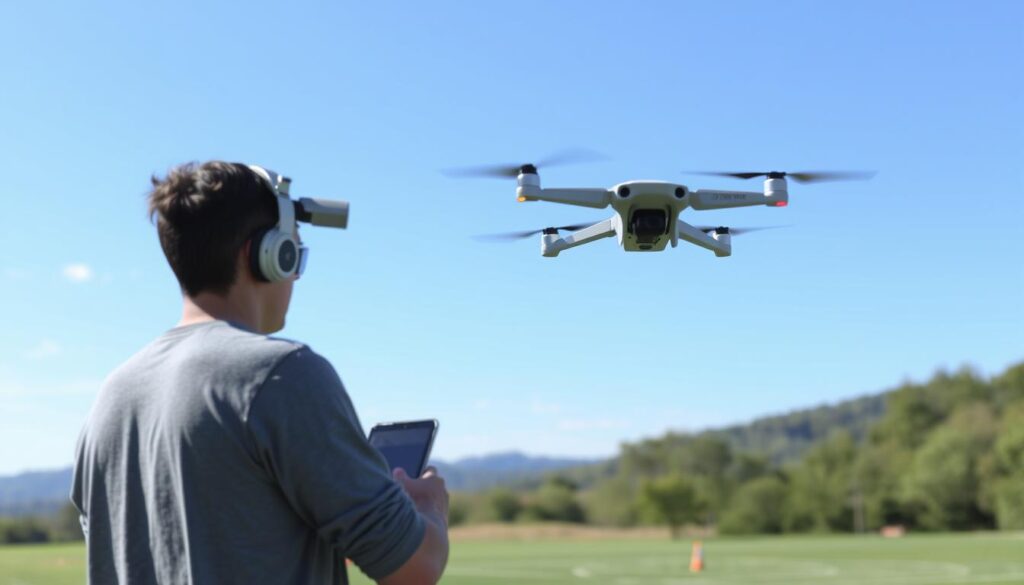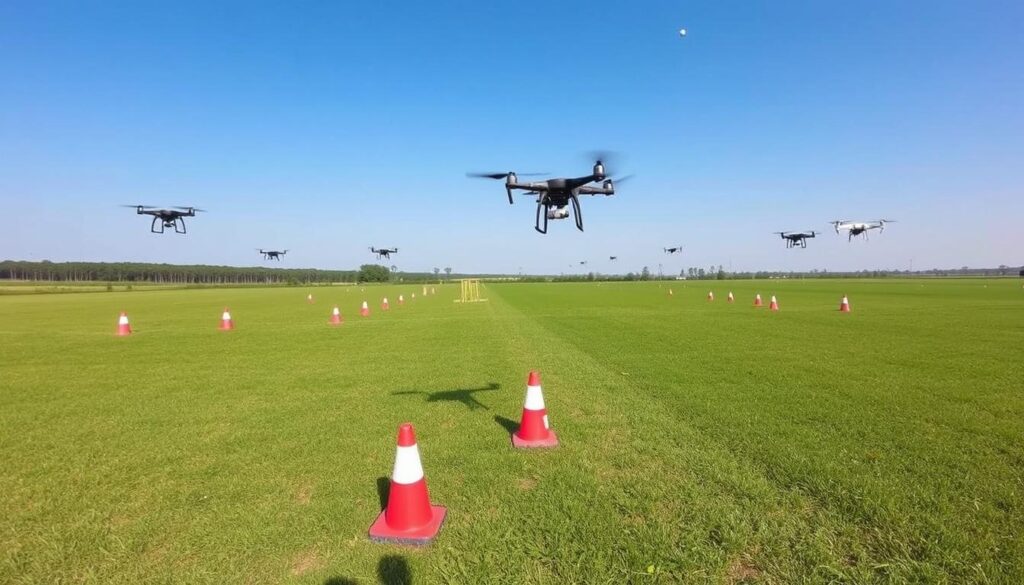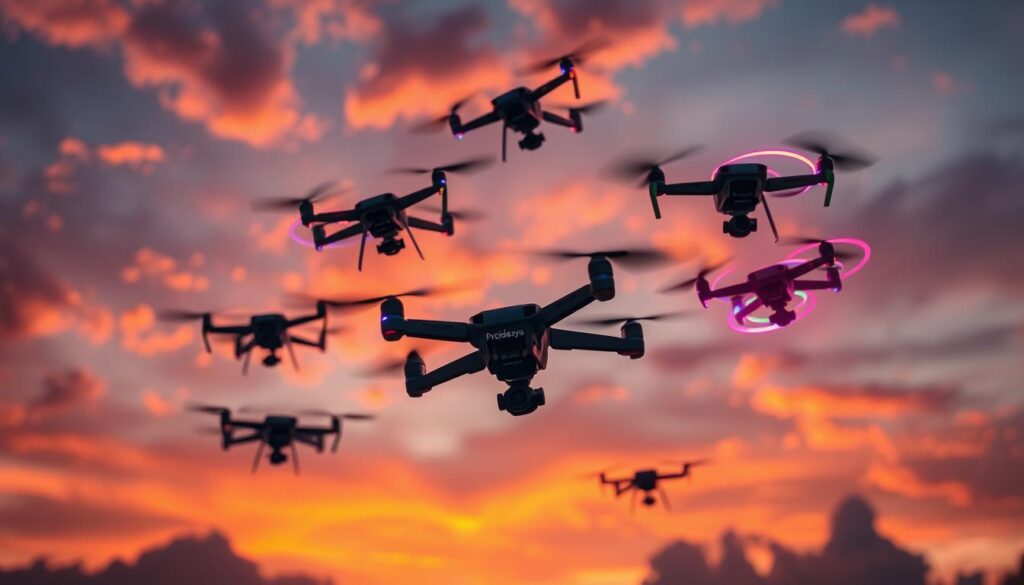Mastering drone flying takes dedication and a desire to learn. This guide offers expert tips and techniques to help you become a confident pilot. It’s perfect for both beginners and experienced flyers, aiming to improve your skills.

Key Takeaways
- Understand the basics of drone controls and flight mechanics
- Practice hovering and altitude adjustments to improve stability
- Choose the right practice location with open spaces and favorable weather
- Develop advanced maneuvers like yaw, pitch, and roll control
- Enhance your aerial videography and photography skills
- Prioritize safety precautions during drone practice
- Consistent practice is the key to becoming a skilled drone pilot
Mastering the Basics of Drone Flight
Before diving into advanced drone moves, you must first grasp the basics of drone flight. This guide will help you learn about the drone controls like throttle, yaw, pitch, and roll. You’ll also discover how to practice drone hovering and adjusting your drone’s altitude. These skills are key for any drone enthusiast.
Understanding Drone Controls
Getting to know the basic drone flying controls is the first step to becoming a skilled drone pilot. The throttle lets you control your drone’s up and down movement. The yaw, pitch, and roll controls help with its side-to-side and rotational movements. Practicing these controls is essential for precise drone flight maneuvers.
Practicing Hovering and Altitude Adjustments
Learning to hover your drone precisely and adjust its altitude smoothly is crucial. Begin by hovering at different heights and aim to hold your position longer and more accurately. Mastering drone hovering practice will boost your confidence and prepare you for more complex drone skills.
| Drone Control Basics | Description |
|---|---|
| Throttle | Controls the up and down movement of the drone |
| Yaw | Rotates the drone left and right |
| Pitch | Tilts the drone forward and backward |
| Roll | Tilts the drone left and right |
By learning these drone control basics and practicing drone hovering and altitude adjustment, you’ll be ready to master drone flight. With a strong foundation, you can then explore more complex drone maneuvers and uses.
Choosing the Right Practice Location
Choosing the right place to practice flying your drone is crucial. You need open spaces where you can fly safely and without obstacles. Also, watching the weather helps make your flying experience better.
Finding Open Spaces for Safe Flying
For good drone practice, find big, open areas. Parks, fields, or big backyards are great. They let you practice flying without worrying about hitting things. These open spaces for drone flying help you learn to hover, adjust altitude, and fly in patterns.
- Look for local parks or areas with lots of space
- Stay away from busy cities or places with lots of things to crash into
- Make sure there are no power lines, trees, or other dangers
Considering Weather Conditions
The weather greatly affects your drone flying. Choose days with little wind, clear skies, and not too hot or cold. Windy days are hard to control, and rain or snow can hurt your drone’s safety and performance.
| Weather Condition | Ideal for Drone Flying | Potential Challenges |
|---|---|---|
| Wind | Light, under 10 mph | Strong, gusty winds can make control difficult |
| Precipitation | Clear skies, no rain or snow | Rain, snow, or fog can reduce visibility and cause issues |
| Temperature | Moderate, between 50°F and 80°F | Extreme cold or heat can affect battery life and drone performance |
By picking safe drone flying areas and thinking about the weather, you can improve your drone flying. A bit of planning and watching the weather will help you become a better drone pilot.
How to practice drone flying?
Mastering drone flying takes regular practice and dedication. It’s important for both beginners and experienced pilots. In this section, we’ll cover practical steps to improve your drone flying skills.
Set Up Your Drone for Practice Sessions
Before flying, make sure your drone is ready. Check the battery, ensure everything is secure, and update any software. Proper setup helps you make the most of your practice time.
Implement Drone Flying Drills and Exercises
Drills and exercises are key to improving your skills. Practice hovering, ascending, descending, and turning. Breaking down your flight helps you focus on each skill.
| Drone Flying Practice Techniques | Benefits |
|---|---|
| Hovering Drills | Improves drone control and stability |
| Figure-Eight Exercises | Enhances coordination and maneuvering skills |
| Altitude Adjustment Practices | Develops precision in vertical control |
| Aerial Photography and Videography Exercises | Hones camera control and framing techniques |
By using these techniques, you’ll improve your drone handling. You’ll build the confidence and skill needed for smooth flying.
Analyze and Reflect on Your Flights
After each flight, analyze your performance. Look at videos or photos and note what worked and what didn’t. This helps you focus on areas for improvement in future sessions.
Remember, consistent practice is crucial for drone flying mastery. Follow these steps and keep challenging yourself to become a skilled drone pilot.

Developing Advanced Maneuvers
After learning the basics of drone flight, it’s time to dive into advanced maneuvers. This guide will help you improve your drone’s yaw, pitch, and roll control. You’ll also learn tips for aerial videography and photography to capture amazing footage and images.
Mastering Yaw, Pitch, and Roll
Learning to control your drone’s yaw, pitch, and roll is key for advanced moves. Yaw is the drone’s rotation around its vertical axis. Pitch is the up-and-down movement of the drone’s nose. Roll is the side-to-side tilt. Practice these movements to get better at controlling your drone’s orientation and movement.
Practicing Aerial Videography and Photography
Creating stunning aerial footage and photos is exciting. Try different camera angles, focal lengths, and flight patterns. Focus on lighting, composition, and how your drone’s movements fit with your video or photo. Improving your drone aerial videography and drone aerial photography skills will elevate your drone flying skills development.
Remember, mastering advanced drone flying maneuvers takes practice and a willingness to try new things. With time and effort, you’ll be able to do complex drone yaw pitch roll control and capture incredible aerial media. This will show off your drone flying skills.

Safety Precautions for Drone Practice
Safe drone flying is key. It’s important to follow safety tips during practice. This ensures a fun and safe experience.
Always keep your drone away from obstacles like trees and buildings. This protects your drone and prevents accidents. Also, watch out for crowded areas and other air traffic.
- Keep a safe distance from obstacles and people
- Be aware of your surroundings at all times
- Follow local regulations and guidelines for drone flying
- Regularly check your drone’s battery life and condition
- Avoid flying in inclement weather conditions
Knowing local drone flying rules is crucial. These rules help keep everyone safe. Following them can also avoid legal trouble.
Check your drone’s battery and condition often. This prevents sudden problems. Always have a spare battery ready. And, never fly in bad weather like strong winds or rain.
| Safety Precaution | Importance | Example |
|---|---|---|
| Maintain safe distance | Protects your drone and prevents accidents | Keep at least 50 meters from obstacles and people |
| Awareness of surroundings | Helps you avoid potential hazards | Check for power lines, trees, and other air traffic |
| Follow local regulations | Ensures legal and responsible drone flying | Adhere to height limits and no-fly zones |
| Monitor drone condition | Prevents unexpected malfunctions | Check battery life and inspect for any damage |
| Avoid poor weather | Minimizes risks of accidents and damage | Don’t fly in high winds, rain, or thunderstorms |
By following these drone flying safety tips and drone safety guidelines, you can reduce risks. This ensures a safe and fun drone flying experience. Remember, safe drone flying is all about drone flying risk mitigation and drone accident prevention.
Conclusion
Mastering drone flying requires dedication, practice, and a focus on safety. You’ve learned the basics and how to do advanced moves. Becoming a skilled drone pilot is very rewarding.
Choosing the right place to practice and watching the weather are key. Always put safety first. These tips will help you improve.
Keep practicing and try new things to grow as a pilot. Look for training resources like local groups, workshops, or online tutorials. There’s a lot to learn and do.
Every flight makes you more confident and skilled. So, keep flying, stay curious, and enjoy the thrill of the skies. This article is just the start of your journey. Happy flying!
FAQ
How do I choose the right drone for practicing?
Look for drones that are easy to control and stable. They should match your skill level. Check the sensors, flight time, and how easy they are to use.
What are some tips for maintaining my drone during practice sessions?
Keeping your drone in good shape is key. Always charge the battery and check the propellers. Clean the sensors often. Follow the maker’s care tips to make your drone last longer.
How can I stay compliant with local drone regulations during practice?
Know the drone laws in your area before flying. Fly in allowed spaces, keep the drone in sight, and avoid airports. Following these rules helps you fly safely and legally.
What are some common mistakes to avoid when practicing drone flying?
Avoid flying too high or far, losing control, and getting too close to things. Be aware of your surroundings. Start simple and build up your skills to avoid accidents and damage.
How can I find a supportive community for practicing drone flying?
Joining a drone community can help a lot. Look for local clubs, online forums, or social media groups. Share tips, ask questions, and practice together. A supportive group can help you get better at flying drones.
What safety gear should I use when practicing drone flying?
Wear a helmet, gloves, and eye protection to stay safe. Also, make sure your drone has guards or cages to prevent crashes or damage.
How can I track my progress and measure my improvement in drone flying?
Keep a log of your practice. Note what you’ve learned, what’s hard, and what you need to work on. Set goals like staying steady or doing certain moves. This helps you see how far you’ve come and what you’ve achieved.